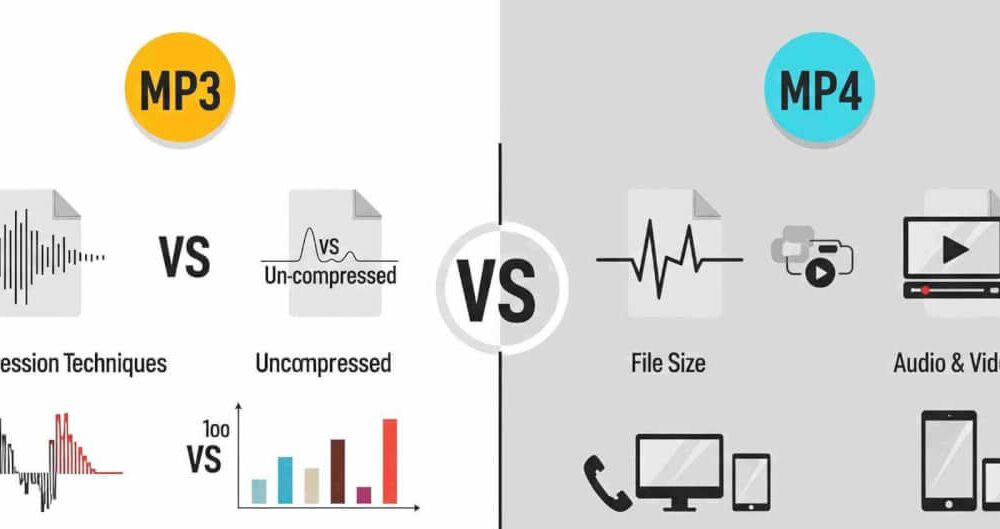MP3 vs MP4: Understanding the Key Differences in Audio and Video Formats

In the digital age, where music, podcasts, videos, and multimedia content dominate our devices and streaming platforms, choosing the right file format can make all the difference in quality, storage, and compatibility. Two of the most ubiquitous formats—MP3 and MP4—often spark confusion among users. MP3 is synonymous with audio files, the go-to for your favorite playlists, while MP4 powers everything from YouTube clips to Hollywood blockbusters. But what exactly sets them apart? Are they interchangeable? And when should you convert one to the other?
This comprehensive guide dives deep into the world of MP3 and MP4, exploring their histories, technical underpinnings, practical applications, and even tips on conversion. Whether you’re a casual listener, a content creator, or a tech enthusiast optimizing your media library, understanding these formats will help you navigate the digital landscape more effectively. Let’s break it down step by step.
A Brief History: From Analog to Digital Revolution
To appreciate the differences between MP3 and MP4, it’s essential to rewind to their origins. Both formats stem from the MPEG (Moving Picture Experts Group) standards, a collaborative effort by engineers in the late 1980s and early 1990s to compress multimedia data without sacrificing too much quality.
MP3, short for MPEG-1 Audio Layer 3, was developed in 1993 by the Fraunhofer Institute in Germany. It emerged as a breakthrough in audio compression, allowing songs to be stored on CDs (which held about 70 minutes of music) to fit on hard drives or early portable players. By the late 1990s, MP3 ignited the Napster era, democratizing music sharing and paving the way for iPods and Spotify. Today, it’s the gold standard for audio, with billions of files circulating worldwide.
MP4, or MPEG-4 Part 14, arrived later in 2003 as part of the broader MPEG-4 suite. Designed not just for audio but for full multimedia, it built on earlier video standards like QuickTime and AVI. Apple’s adoption in iTunes and the rise of online video platforms like YouTube in 2005 propelled MP4 to stardom. Unlike MP3’s audio-only focus, MP4 was engineered for the internet age, supporting streaming, high-definition video, and interactive elements like subtitles and metadata.
In essence, MP3 was born from the need to shrink audio files for personal use, while MP4 evolved to handle the explosive growth of video content in a broadband world. This historical divergence shapes their core identities to this day.
Technical Breakdown: How MP3 and MP4 Work Under the Hood
At their core, MP3 and MP4 are compression formats, but they operate on vastly different principles.
MP3: Audio Compression Mastery
MP3 uses perceptual coding, a clever technique that analyzes human hearing. It discards audio data that falls outside our audible range (like frequencies above 20kHz) or sounds masked by louder ones—a process called psychoacoustics. This lossy compression reduces file sizes by up to 90% compared to uncompressed WAV files, all while maintaining “good enough” quality for most ears.
Key specs:
- Bitrate: Typically 128–320 kbps; higher means better quality but larger files.
- Sampling Rate: 44.1 kHz (CD quality) is standard.
- Channels: Supports stereo and mono.
- File Extension: .mp3
The result? A 4-minute song might weigh just 3–5 MB, perfect for mobile storage.
MP4: The Versatile Container
MP4 isn’t a single codec but a container format, like a digital Swiss Army knife. It can encapsulate various codecs: H.264 or H.265 for video, AAC for audio (ironically, a successor to MP3), and more. This flexibility allows MP4 to bundle video, audio tracks, chapters, and even 3D elements into one file.
Key specs:
- Compression: Lossy for video/audio, but supports lossless modes.
- Resolution Support: From 240p to 8K+.
- Frame Rate: Up to 120 fps for smooth motion.
- File Extension: .mp4 (also .m4a for audio-only variants).
An MP4 file for a 2-minute HD video clip could range from 10–50 MB, depending on compression. Its structure uses ISO base media file format (ISOBMFF), enabling efficient streaming—think adaptive bitrate for Netflix.
In short, MP3 is a streamlined audio specialist, while MP4 is a multimedia powerhouse. Converting audio from MP4 to MP3 often involves extracting the audio track and re-encoding it, which we’ll cover later.
Use Cases: When to Choose MP3 Over MP4 (and Vice Versa)
The choice between MP3 and MP4 boils down to your content’s needs. Here’s a practical comparison:
| Aspect | MP3 | MP4 |
| Primary Use | Music, podcasts, audiobooks, ringtones | Videos, movies, tutorials, social media clips |
| Best For | Audio-only playback on low-bandwidth devices | Full audiovisual experiences, streaming |
| Examples | Spotify playlists, voice memos | YouTube vlogs, TikTok reels, Blu-ray rips |
| Storage Efficiency | Excellent for audio (small files) | Good for video, but larger overall |
| Editing | Simple trimming in DAWs like Audacity | Complex in tools like Adobe Premiere |
If you’re archiving a podcast episode, MP3’s simplicity shines—no need for video overhead. Conversely, for a wedding highlight reel, MP4’s video capabilities are indispensable. Interestingly, MP4 can mimic MP3 by using its .m4a extension for audio-only files, which often deliver superior sound quality thanks to AAC encoding.
Quality and File Size: A Head-to-Head Battle
Quality is subjective, but data doesn’t lie. MP3 at 320 kbps rivals CD audio for most listeners, with artifacts like “swishing” only noticeable in quiet passages. MP4’s audio (via AAC) typically edges out MP3 in efficiency—delivering similar quality at lower bitrates (e.g., 256 kbps AAC sounds like 320 kbps MP3).
File size-wise:
- A 5-minute MP3 song: ~4 MB at 128 kbps.
- The same audio in MP4 (.m4a): ~3.5 MB, thanks to better compression.
For video, MP4’s magic is in balancing visuals and sound. A 1080p MP4 clip compresses better than older formats like AVI, reducing sizes by 50–70% without visible loss.
Pro tip: Always aim for variable bitrate (VBR) in both for optimal results—it’s smarter than constant bitrate (CBR).
Compatibility: Playing Nice Across Devices and Platforms
In 2025, both formats are near-universal, but nuances persist.
- MP3: Supported on 99% of devices—phones, cars, smart speakers. It’s the fallback for legacy systems like old MP3 players.
- MP4: Dominant in web browsers (via HTML5), mobiles (iOS/Android), and consoles. However, some older TVs or software might need codecs like H.264 enabled.
Cross-platform winners? VLC and Windows Media Player handle both effortlessly. For web embeds, MP4’s streaming prowess makes it the default for sites like Vimeo.
If compatibility issues arise, conversion is your friend—more on that below.
Converting Between MP3 and MP4: Tools and Best Practices
Sometimes, you need to bridge the gap: extract audio from a video (MP4 to MP3) or embed music into visuals (MP3 to MP4). Conversion involves re-encoding, which can slightly degrade quality, so use high bitrates.
MP4 to MP3: Extracting Audio from Videos
This is common for turning YouTube tutorials into podcasts. Steps:
- Upload your MP4 file to a reliable MP4 converter.
- Select MP3 as the output format and tweak bitrate (recommend 192–320 kbps).
- Download the stripped audio file.
For batch processing, desktop tools like FFmpeg work, but online options are user-friendly. One standout recommendation is AhaConvert, a free, no-watermark tool that handles conversions swiftly while preserving quality. It supports drag-and-drop and even cloud uploads for large files.
MP3 to MP4: Adding Video to Audio Tracks
Ideal for lyric videos or audiobooks with visuals. Process:
- Import your MP3 into editing software like iMovie or HandBrake.
- Add a static image or simple animation as the video layer.
- Export as MP4.
Again, AhaConvert excels here—upload your MP3, attach an image, and convert to MP4 in seconds. It’s ad-free and prioritizes privacy, deleting files post-conversion.
MP4 to MP4: Optimizing Without Loss
Wait, converting MP4 to MP4? Yes, for remuxing (repackaging without re-encoding) to reduce size or fix compatibility. Tools like AhaConvert let you select “remux” mode, swapping codecs if needed (e.g., H.264 to H.265 for smaller files).
Best practices: Avoid unnecessary re-encodes to prevent quality dips. Test outputs on target devices, and back up originals.
Pros and Cons: Weighing the Trade-Offs
No format is perfect—here’s a balanced view:
MP3 Pros:
- Tiny file sizes for audio.
- Universal compatibility.
- Mature ecosystem of players and editors.
MP3 Cons:
- Lossy; no video support.
- Aging tech—AAC in MP4 often sounds better at same size.
- Limited metadata (e.g., no chapters).
MP4 Pros:
- Versatile for audio + video.
- Superior compression for modern media.
- Streaming-optimized with adaptive features.
MP4 Cons:
- Larger files for pure audio.
- Requires more processing power.
- Codec dependencies can cause playback hiccups.
Overall, MP3 wins for simplicity, MP4 for sophistication.
The Future: Evolving Standards and Emerging Trends
As of October 2025, both formats endure, but shifts are afoot. MP3 remains entrenched in legacy audio, though services like Apple Music favor AAC (MP4’s audio core). MP4 is adapting to AV1 and VVC codecs for 8K streaming, driven by 5G and AR/VR.
Sustainability matters too: Efficient compression reduces data center energy use. Tools like AhaConvert are jumping on this with eco-friendly, low-resource conversions.
Looking ahead, hybrid formats blending MP3’s lightness with MP4’s flexibility (e.g., WebM) could blur lines further.
Conclusion: Picking Your Format for the Digital Symphony
MP3 and MP4 aren’t rivals—they’re teammates in the multimedia orchestra. MP3 keeps your tunes portable and punchy, while MP4 orchestrates immersive experiences. The “better” one depends on your goal: audio purity or audiovisual flair?
If conversion is in your workflow, lean on trusted tools like AhaConvert for seamless, secure results. Experiment, compare file sizes and quality on your setup, and you’ll master the formats in no time. What’s your go-to—MP3 for the commute or MP4 for movie nights? Share in the comments below!

Source: MP3 vs MP4: Understanding the Key Differences in Audio and Video Formats




